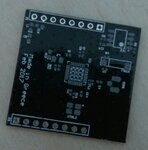jgabcgr
Newbie level 4
I made a pcb with a QFN32 with exposed pad but I feel like I've made a mistake on the stencil, in the exposed pad area. I managed to solder it and the chip (CC1310) is programmed successfully but I'm still concerned about the stencil. The solder paste looks like a chess on the exposed pad and I don't think that this is the right pattern.

